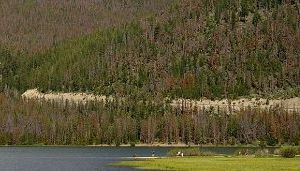Agriculture secretary says EPA ruling on biomass could help mitigate wildfire danger
U.S. Agriculture Secretary Tom Vilsack today praised the U.S. Environmental Protection Agency (EPA) for delaying for three years carbon dioxide emissions permits for biomass boilers that convert wood and other plant material into energy.
“I strongly support EPA's announcement today that it is starting an expedited rulemaking so that it can defer for three years greenhouse gas permitting requirements for biomass and that it is also undertaking a scientific assessment of how emissions from biomass should be treated under the Clean Air Act,” Vilsack said in a release.
The move is significant in Colorado because backers of biomass energy say that more 2 million acres of national forest land hit hard by a mountain pine park beetle epidemic could be tapped to generate hot-water heat and electricity that would actually replace dirtier fuel sources like coal and natural gas. The EPA delay makes that process more realistic.
“We are working to find a way forward that is scientifically sound and manageable for both producers and consumers of biomass energy,” EPA administrator Lisa Jackson said, according to Reuters. “In the coming years, we will develop a common sense approach that protects our environment and encourages the use of clean energy.”Utility scale biomass power plants, much more common in Europe, have been proposed in different parts of Colorado, including a plan in Vail that stalled due to a lack of Department of Energy funding. The push for biomass power as a way to thin dead forests near mountain communities drew more interest this past fall during a brief but intense wildfire season that saw the most destructive blaze in state history with Boulder's Fourmile Canyon Fire.
“America's forest owners, farmers and ranchers can play a crucial role in providing renewable energy from wood, switchgrass and other agricultural products,” Vilsack said. “Homegrown energy can provide jobs in rural America while reducing greenhouse gases. Markets for woody biomass in particular can be especially important in allowing the U.S. Forest Service and other landowners to reduce the threat of catastrophic wildfire while restoring more natural conditions in our forests.”
Critics of using forest products for power worry that it will become an excuse to push more roads into the national forest, overly log certain areas and ultimately create a market that still emits greenhouse gases. However, high-heat wood gasification – in wide use in Europe – actually can be carbon neutral when compared to the potential emissions of a dead and biodegrading forest or one struck by an intense wildfire. And the power generally is used to replace sources such as coal and natural gas.
“EPA's action today will provide the agency with the time it needs to ensure that greenhouse gas policies properly account for the emissions and carbon sequestration associated with biomass,” Vilsack said. “In many cases, energy produced from biomass will provide significant reductions of greenhouse gases relative to fossil fuels. USDA looks forward to working with EPA in ensuring that this administration's policies use the best science and spur innovation and job creation in the renewable energy sector.”
“I strongly support EPA's announcement today that it is starting an expedited rulemaking so that it can defer for three years greenhouse gas permitting requirements for biomass and that it is also undertaking a scientific assessment of how emissions from biomass should be treated under the Clean Air Act,” Vilsack said in a release.
The move is significant in Colorado because backers of biomass energy say that more 2 million acres of national forest land hit hard by a mountain pine park beetle epidemic could be tapped to generate hot-water heat and electricity that would actually replace dirtier fuel sources like coal and natural gas. The EPA delay makes that process more realistic.
“We are working to find a way forward that is scientifically sound and manageable for both producers and consumers of biomass energy,” EPA administrator Lisa Jackson said, according to Reuters. “In the coming years, we will develop a common sense approach that protects our environment and encourages the use of clean energy.”Utility scale biomass power plants, much more common in Europe, have been proposed in different parts of Colorado, including a plan in Vail that stalled due to a lack of Department of Energy funding. The push for biomass power as a way to thin dead forests near mountain communities drew more interest this past fall during a brief but intense wildfire season that saw the most destructive blaze in state history with Boulder's Fourmile Canyon Fire.
“America's forest owners, farmers and ranchers can play a crucial role in providing renewable energy from wood, switchgrass and other agricultural products,” Vilsack said. “Homegrown energy can provide jobs in rural America while reducing greenhouse gases. Markets for woody biomass in particular can be especially important in allowing the U.S. Forest Service and other landowners to reduce the threat of catastrophic wildfire while restoring more natural conditions in our forests.”
Critics of using forest products for power worry that it will become an excuse to push more roads into the national forest, overly log certain areas and ultimately create a market that still emits greenhouse gases. However, high-heat wood gasification – in wide use in Europe – actually can be carbon neutral when compared to the potential emissions of a dead and biodegrading forest or one struck by an intense wildfire. And the power generally is used to replace sources such as coal and natural gas.
“EPA's action today will provide the agency with the time it needs to ensure that greenhouse gas policies properly account for the emissions and carbon sequestration associated with biomass,” Vilsack said. “In many cases, energy produced from biomass will provide significant reductions of greenhouse gases relative to fossil fuels. USDA looks forward to working with EPA in ensuring that this administration's policies use the best science and spur innovation and job creation in the renewable energy sector.”
![]() 0 Comments on "Agriculture secretary says EPA ruling on biomass could help mitigate wildfire danger"
0 Comments on "Agriculture secretary says EPA ruling on biomass could help mitigate wildfire danger"
Be the first to comment below.



 Vail Town Council to weigh new plan to redevelop T...
Vail Town Council to weigh new plan to redevelop T...  All about indexes
All about indexes  Transforming your social security into a winning r...
Transforming your social security into a winning r...  Pass sales, real estate transactions, revenues inc...
Pass sales, real estate transactions, revenues inc...  Vail Valley native with passion for Biophilic inte...
Vail Valley native with passion for Biophilic inte...  Beaver Creek starts work on new summer activities
Beaver Creek starts work on new summer activities  Land Trust, ECO Trails, Vail Resorts team up to cl...
Land Trust, ECO Trails, Vail Resorts team up to cl...  EUROVISION named Host Broadcaster for 2015 World A...
EUROVISION named Host Broadcaster for 2015 World A...  Vail Resorts brings back Lindsey Vonn's 'School of...
Vail Resorts brings back Lindsey Vonn's 'School of...  Hundreds turn out for 2015 World Championships vol...
Hundreds turn out for 2015 World Championships vol...  Eagle County Senior Health Expo and 9th Annual Hea...
Eagle County Senior Health Expo and 9th Annual Hea...  Final race of Vail Mountain Trail Running Series s...
Final race of Vail Mountain Trail Running Series s...  Before you write your will ...
Before you write your will ...  2015 World Ski Championships volunteer recruitment...
2015 World Ski Championships volunteer recruitment...  Ascent Sotheby’s International Realty in Vail an...
Ascent Sotheby’s International Realty in Vail an...  CDOT outlines road closures for local stages of US...
CDOT outlines road closures for local stages of US...  Italian artist creates unique trophies for Vail, B...
Italian artist creates unique trophies for Vail, B...  Vail Recreation District once again hosting Jake W...
Vail Recreation District once again hosting Jake W... 

